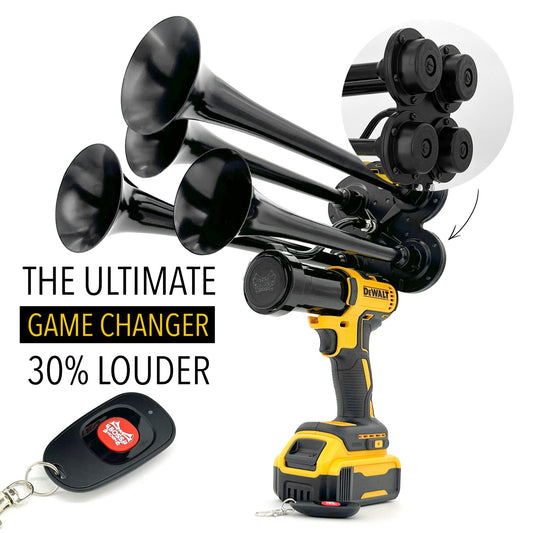Truck horns have long been utilized as a vital means of communication between drivers on the road. With a distinctive sound that can be heard from a considerable distance, these horns ensure safety and alert others on the highways. However, the loudness of these horns has raised concerns over the years, leading to regulations and standards being put in place to mitigate their impact on both the environment and public health.
Throughout history, truck horns have evolved alongside the development of vehicles themselves. Initially, these horns were manual and required physical effort from the driver to produce the necessary sound. With advances in technology, electric horns emerged, allowing for a more convenient and reliable way to signal warnings. As trucks became larger and more prevalent, the significance of these horns grew, making them an essential component of road safety.
The current significance of truck horn decibels lies in the realm of noise pollution control and public health concerns. Excessive noise can have detrimental effects on individuals, leading to stress, sleep disturbances, and potential hearing damage. Recognizing these risks, regulatory bodies have introduced limits on the loudness of truck horns, ensuring that they remain within acceptable levels.
One compelling statistic that sheds light on the impact of loud truck horns is the correlation between noise pollution and accidents. According to studies, prolonged exposure to excessive noise on the road can contribute to driver fatigue and distraction, thereby increasing the likelihood of accidents. By enforcing regulations on truck horn decibels, authorities aim to minimize these risks and create safer driving conditions.
To address the issue of loud truck horns, manufacturers have begun implementing soundproofing measures within the design of their vehicles. By incorporating materials that reduce noise transmission and installing more efficient horn systems, the overall impact of truck horns on the surrounding environment can be significantly reduced. Through these innovations, manufacturers strive to strike a balance between maintaining the functionality of truck horns while minimizing their disruptive effects.
In conclusion, the evolution of truck horns has brought about concerns regarding their loudness and the resulting impact on both the environment and public health. Recognizing these concerns, regulations have been implemented to ensure that truck horn decibels remain within acceptable limits. Manufacturers, in turn, have begun implementing soundproofing measures to reduce noise transmission and create a safer and more pleasant road environment for everyone.
Truck Horn Decibels: How Loud is Too Loud?
The Importance of Horn Decibels in Trucks
Truck horns play a critical role in ensuring road safety, alerting pedestrians and other vehicles of potential dangers. The sound produced by truck horns needs to be loud enough to get attention but not so loud that it becomes a nuisance or causes hearing damage. This is where horn decibels come into play.
What are Horn Decibels?
Horn decibels, also known as sound pressure levels (SPL), measure the intensity or loudness of sound. It is a unit used to quantify the sound produced by a truck horn. The decibel scale is a logarithmic scale, meaning that every increase of 10 decibels corresponds to a tenfold increase in sound intensity. This scale is used to evaluate and regulate the noise levels produced by truck horns.
Regulations on Truck Horn Decibels
To ensure road safety and reduce noise pollution, many countries and regions have established regulations regarding the maximum allowable decibel level for truck horns. These regulations vary globally, and it's essential for truck drivers and manufacturers to comply with the specific requirements of the region they operate in.
In the United States, the Department of Transportation (DOT) has set specific rules under the Code of Federal Regulations (CFR) regarding truck horn sound levels. According to CFR Title 49 – Transportation, Part 325, the maximum permissible sound level for a truck horn is 110 decibels measured at a distance of 50 feet.
Factors Affecting Horn Decibels
Several factors can influence the decibel levels of a truck horn. These include:
- Horn Design: The design of the horn, including its shape, size, and materials used, can impact the sound output and resulting decibel level.
- Power Source: The type of power source used for the horn, whether it's an air or electric horn, can affect the decibel level produced.
- Weather Conditions: Environmental factors such as temperature, humidity, and wind speed can influence how sound travels and is perceived, potentially affecting the perceived decibel level.
- Distance: The distance at which the horn sound is measured can impact the perceived decibel level. Sound intensity decreases as the distance from the source increases.
The Impact of Horn Decibels on Public Health
Excessive exposure to loud noises can have adverse effects on human health, including hearing loss, tinnitus, and increased stress levels. Therefore, managing and regulating horn decibels in trucks is crucial to mitigate the potential negative impact on public health.
Statistics: Noise-Related Health Issues
According to the World Health Organization (WHO), approximately 1.1 billion young people worldwide are at risk of hearing loss due to exposure to unsafe sound levels. Additionally, chronic exposure to noise pollution has been associated with cardiovascular diseases, cognitive impairment in children, sleep disturbances, and decreased quality of life.
These alarming statistics highlight the importance of establishing and enforcing regulations regarding truck horn decibels to protect public health and promote safer roadways.
https://youtube.com/watch?v=Xf_PXoM7lYI
1. Understanding Truck Horn Noise Levels
Why is it important to understand the noise levels produced by truck horns?
It is crucial to comprehend the impact of truck horn noise levels as it directly affects public safety, environmental regulations, and driver awareness.
Three important pieces of information:
- Truck horn noise levels have the potential to cause hearing damage to pedestrians and other drivers if they are excessively loud.
- Excessive noise pollution from truck horns can disrupt residential areas, affecting the quality of life for nearby communities.
- Understanding and adhering to legal noise regulations helps maintain compliance and minimize potential fines for truck owners and operators.
2. Factors Influencing Truck Horn Noise
What factors contribute to the noise produced by truck horns?
Several elements play a role in determining the noise levels generated by truck horns, including the horn design, type of horn, and the air pressure applied.
Three important pieces of information:
- The design and construction of the horn impact the sound emitted, with different shapes and materials producing varying noise levels.
- Truck horns can come in various types, such as electric, air, or train horns, each having different noise characteristics.
- The air pressure supplied to the horn significantly influences the sound volume.
3. Protecting the Public from Excessive Noise
How can the public be safeguarded from excessive truck horn noise?
To ensure public safety and reduce noise-related disturbances, specific regulations and guidelines are in place, including noise level limits and rules of usage.
Three important pieces of information:
- Government authorities set noise level limits that restrict the maximum volume of truck horns to protect the general public from excessive noise exposure.
- Some jurisdictions have designated quiet zones where the use of truck horns may be limited or prohibited to maintain tranquility, particularly near hospitals or schools.
- To educate drivers on the proper use of truck horns, guidelines are in place to discourage unnecessary honking and promote responsible horn usage.
4. Measuring & Monitoring Truck Horn Noise Levels
How are truck horn noise levels measured and monitored?
Truck horn noise levels are measured using specialized equipment called sound level meters, which capture the decibels (dB) produced by the horn.
Three important pieces of information:
- Sound level meters are calibrated devices that measure the intensity of sound in decibels, providing an objective measurement of truck horn noise levels.
- Monitoring truck horn noise levels may involve periodic sound level testing by authorities to ensure compliance with legal requirements.
- Truck owners and operators can also monitor their vehicle's noise levels to proactively address any potential issues.
5. Reducing Truck Horn Noise
What measures can be taken to mitigate the noise produced by truck horns?
To minimize the impact of truck horn noise, various mitigation strategies can be applied, including soundproofing techniques, horn maintenance, and driver training.
Three important pieces of information:
- Soundproofing measures such as installing noise barriers or utilizing sound-damping materials can help reduce the noise transmitted from truck horns.
- Regular maintenance of truck horns, including inspection and adjustment, can ensure their optimal functioning and minimize excessive noise emission.
- Driver training programs focused on horn usage etiquettes and the importance of selective and judicious horn use can significantly reduce noise pollution caused by truck horns.
In conclusion, understanding truck horn noise levels is crucial to ensure public safety and adhere to legal regulations. Factors such as horn design and air pressure contribute to the noise produced, while monitoring and reducing noise levels require specialized equipment and mitigation strategies. By implementing measures to minimize noise pollution and practicing responsible horn usage, we can help create a quieter and more sustainable environment for everyone.
Conclusion
In conclusion, truck horn decibels play a crucial role in ensuring safety and communication on the roads. It is important for truck drivers and manufacturers to adhere to noise regulations to prevent unnecessary noise pollution and protect public health.
The decibel level of a truck horn has a direct impact on its effectiveness in alerting other road users. A truck horn with a higher decibel rating will have a wider range and can be heard from a greater distance, improving overall safety.
Noise regulations, such as the Federal Motor Carrier Safety Administration's limit of 110 decibels, ensure that truck horns are not excessively loud and disruptive. These regulations aim to strike a balance between effective communication and preventing noise pollution.
Engineers and manufacturers continue to work on developing truck horns that produce sound at lower frequencies, which can be more easily heard and detected by pedestrians and cyclists. This innovation shows promise in improving safety for all road users.
Truck drivers should also be mindful of the appropriate use of their horns, as unnecessary honking can contribute to noise pollution and is often perceived as aggressive or rude. Using the horn for emergency situations and as a means of communication in potentially dangerous situations is the best practice.
Overall, understanding truck horn decibels is essential for maintaining safety and promoting a harmonious coexistence on the roads. Compliance with noise regulations and responsible use of truck horns are key factors in ensuring efficient communication and reducing noise pollution for the benefit of all.














